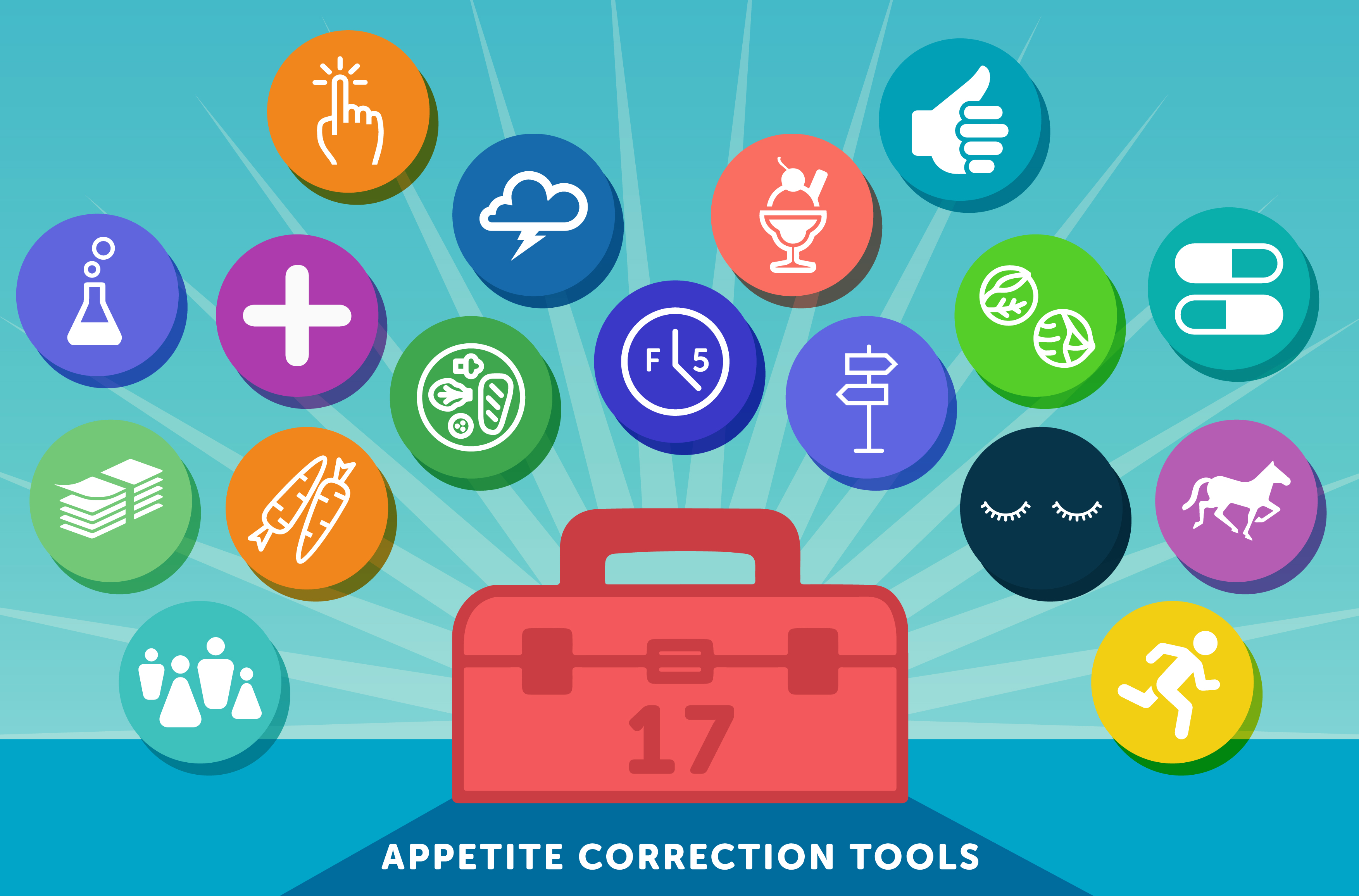Recently, I was asked, “What’s the difference between Fast-5 and appetite correction (AC)?” The difference between Fast-5 and AC is the difference between a hammer and a house: the former is a tool you use to create the latter, a place you live in long-term. Just as a hammer may not be the only tool you need to build a house, Fast-5 may not be the only tool you need to correct your appetite.
Appetite correction: the gleaming holy grail of weight loss
Let’s look at appetite correction, which is the gleaming holy grail of weight loss. You might ask how appetite correction can be the holy grail of weight loss when you’ve been dieting and working on weight loss for years, but have never heard of appetite correction. After all, isn’t the goal of dieting to achieve some specific weight?
You haven’t heard of appetite correction because for decades weight loss regimens have emphasized fixing what is perceived as an individual failure. The thinking goes like this: “If you have too much fat, something must be wrong with you. Your willpower is weak. Your metabolism is messed up. You’re not eating right. You’re lazy.” So, the traditional approach to excess fat has been to offer up one crutch or another to fix you, such as surgery or one of the many crutches requiring you to shell out money endlessly: drugs, packaged food portions, fitness centers, etc.
Your body is not the problem
That’s baloney, (bologna for the spelling bee regional champs). There’s nothing wrong with you—your body, brain and willpower are doing just fine. If you traveled in time to 100 years ago and lived the average lifestyle on the average food intake in an environment with no processed food, greatly reduced food availability, more manual chores, walking most places and fewer prompts to eat in the form of advertising and social pressure, your body would gradually drop most, and probably all, of any excess fat you now carry. Your brain’s built-in appetite center would guide you to eat the right amount—not too much, not too little. You’d eat just the right amount with no foods off limits and no calorie counting. In a 1916 world, your appetite center would function like it should.
Take a look—do a Google search on “1916 family photo.” Do you see any overweight people? The photos are almost all of Caucasians, unfortunately, so they’re not very representative of most communities in 2016, but maybe you can find an overweight person here and there. Do you see any overweight children? I found none.
Today, in developed countries like the USA/UK/EU/AU/NZ as much as two thirds of people are carrying excess fat and are considered overweight or obese. Has something gone wrong with two-thirds of human bodies? No! They’re made from the same stuff using the same genes that the 1916 bodies were; they are just a branch or two farther out on the family tree.
Culture is the problem and our bodies pay the price
If our genes and our bodies haven’t changed, what has? Look at all the animals in the world that aren’t human fed…are they having an obesity epidemic? No, so it’s not something in the air or the water. What has changed is our culture, which now pushes us to eat too much and too often. We’re paying the price in the form of excess fat and serious health consequences.
Let’s jump back to 2016 on Google to see how things look: 2016 family photo. What do you see now? A bunch of crap: politicians, celebrities, TV shows, advertisements, cars and Kardashians — the very stuff that’s responsible for much of the cultural shift toward overweight and obesity.
The Kardashians aren’t solely responsible for the obesity epidemic. As far as I know, they’re not responsible for anything, but they’ve had plenty of weight struggles of their own under the tabloid microscope. They are, however, among the TV entertainment celebrities who have helped shift the typical American family’s evening activity from the 1916 standard of storytelling, games, music, chores or reading with a bedtime soon after sunset to a sedentary TV-centered vigil perforated by relentless salvos of commercials: a 3-5 hour block of time during which a person will burn only a few more calories than when sleeping. The summary: our culture drives overeating and lures us into inactive pastimes.
Achieve appetite correction: no time machine required
In spite of our feeding-frenzy culture, we don’t have to time-travel to achieve appetite correction. There are tools you can use to shield yourself—and your appetite center in particular—from the barrage of eating prompts that we encounter daily. AC tools don’t involve drugs, surgery, a gym membership, packaged foods or shakes. The most powerful tool for correcting your appetite is Fast-5, which acts through both physiology and psychology to short circuit all those eating prompts. And when you’ve found and implemented the tools you need to achieve appetite correction, your appetite center says “no,” to food, so your willpower doesn’t have to.
Fast-5 allows for a daily five-hour eating window so you can get the food you need. If you have surplus fat, you don’t need much, because the bulk of what you need (fuel) comes from fat that you stored when you ate more than you needed—yesterday, last week, last year or during your “roaring twenties” (Erté, Bruté?)…it doesn’t matter when. The reality is the extra fat is there. The rest of the time (19 hours), it’s relatively easy to say “no” to food—it’s especially easy during the eight hours or so that you’re sleeping each day. Because Fast-5 is clock-based, you don’t have to make decisions about food all day. You don’t have to have extra-strong willpower. It’s either time to eat or it’s not. If it’s not, your brain and body have a fairly easy time waiting until it is, because you haven’t said “no”—you’ve said “not now.”
Fast-5: time tested by thousands for over ten years

Fast-5 is a hammer, and it’s the best tool I know: powerful, flexible, durable and tested by thousands of users for over ten years. Fast-5 requires no calorie counting—your appetite center will do that for you, just as it does for all those wild animals out there that have brain wiring similar to ours for basic functions like appetite, breathing, heartbeat, libido, and balance. AC is the healthy house you want to live in for the rest of your life: a comfortable and satisfying place where you get lean and stay lean without too much maintenance work. The AC toolkit includes Fast-5 and 16 other appetite-correcting tools that help you shield yourself from the 2016 overeating culture and it’s available here.



26 comments
Dr Bert I am so thankful I found your material a few years ago I have read AC book multiple times because it helps remind me of all the things that are working against us in our journey I am 58 a Marine also SEMPER FI that has struggled with food addiction. I am in a normal BMI that I achieved with alot of hard work before i found your material I just want people to know that the Fast 5 is the most valuable thing to losing or just maintaining Thanks again wish I would have found it sooner Semper Fi Marine
Dr. Bert,
I know IF works. I have read several books over the years and tried it on occasion. Since I met my husband over 5 years ago I’ve gained 60 pounds. I believe the reason is his absolute insistence on 3 meals a day and my lack of will power to object. I’m to the point however, that I’m over it. I’m always uncomfortable. I can’t move easily. My sex drive has gone down the drain. And I’m generally annoyed. I think an app could be a helpful tracking tool but I am annoyed by the fact that IF apps insist on telling you how to live your life by creating a personal plan. I don’t want to upgrade. I don’t need a personal plan. I just want to track what I happen to choose to do each day without constantly being prompted to upgrade and pay. Any suggestions?
I looked into creating an app many years ago, but didn’t want to take away from the “app” that our bodies already have built-in — that’s the one that IF usually gets working when it wasn’t before. This answer is slow in coming because I missed the notification, so I hope by now you’ve found a solution to the husband-driven problem.
Dr. Bert:
Two questions:
1) Is Fast 5 feasible for someone who has Parkinson’s and takes Sinemet? BTW: Will Fast 5 help with Parkinson’s symptoms?
2) Why not Fast 6? Why is 5 the magic number?
Thank You
Regarding question 1, please ask the doctor prescribing the Sinemet. For question 2, 5 hours is a happy medium between being a short enough window to get most people who try it to appetite correction, which is often not seen with longer windows. Five hours is still generous enough to allow one to eat without feeling like they must eat extra because it’s their only chance to eat, and it does not restrict social eating as much as a shorter window would. It’s disappointing to see that some people start with 16:8 or 18:6 and give up because they think IF isn’t going to work for them. Also, a survey we did in 2016 showed better results for those with a 5-hour window than those with longer windows. There’s not much difference between a 4-, 5- and 6-hour window, but we’d like to see everyone have their best chance of success with a schedule they can sustain indefinitely, and is no more restrictive than it has to be. The 5-hour window seems to do that well.
Hi Dr Bert,
1. I am interested in intermittent fasting, but I did not try it before – Should I buy both books of you: “the fast-5” and “the AC”;
2. I am in a normal bmi, how should I measure my weight maintenance?
3. Although I am in a normal bmi, I may change my eating style to intermittent fasting (my current eating style was not possible For my new job schedule and I am searching for a new eating style – I tried IF once yesterday, it was very hungry: How do I know that the hunger was real or was just not adapting the new IF yet?
Thanks
Onward
Except for some of the scientific explanation about fat burning, the AC book includes all of the info on Fast-5, so AC is the one to buy. If money’s tight, the Fast-5 book is available as a free download here: https://shop.bertherring.com/products/the-fast-5-diet-and-the-fast-5-lifestyle-ebook.
I suggest measuring weight maintenance by your goal body — this is discussed in the AC book.
It usually takes 3-4 days from a sudden start (“cold turkey” adaptation, also in the book) for the fat-burning enzymes to be assembled and start working. After that, things get much easier — so much easier, and with so much time and money savings that people often wonder why they didn’t do this before. The reason is that hunger like you had often stops people if they don’t know it gets better quickly.
Thank you very much and I am reading the “AC” book.
someone told me about this FAST_5 program and I am highly interested in trying it out. I’m 45 year old female overweight and pretty healthy otherwise. should i check with by PCP before beginning this program or just give it a shot?
Healthy people typically have no problems stretching out the fasting interval between meals to 19 hours, but if you have concerns, there’s no harm in discussing it with your PCP first. Some may be unaware of IF and the studies supporting it, so if you find the response discouraging, ask for specific reports or research rather than accepting the marketing-driven answers of “breakfast is the most important meal of the day” or “you have to keep your metabolism up.”
Dr. Bert, I’m doing Eutirox 112. Hashimoto’s disease. I’m 65, 1,63mt and 83 kgs.
I have my endocrinologist who is not in favor of your fast five theory. I have tried it and lost 2 kgs doing the fasting for two months. I feel really great doing it.
I have recently been diagnosed with an adenoma in my adrenals. Problems with my cortisol values. I have not yet started any treatment.
My cholesterol is 250. Although I have a good HDL, my LDL is 176.
I must absolutely loose weight, also for my mental health and my self estime.
I’m doing Pilates 4 times a week.
Shall I continue following your method?
Thank you for your advices.
Thank you also for this approach to live a longer and healthier life.
Cristina Garcia
i cannot legally or morally act as your physician by offering medical advice. There is no substitute for being able to see you in real life. If your endocrinologist is not aware of the benefits of short-term fasting, or even willing to observe as you experiment, it may be wise to see if another endocrinologist is available. In any case, your doctor is your advisor, not a puppeteer. You can collect information, integrate it with your experience, and select the path that looks best for your health. The choices may not be easy, but in the end, compliance with a physician’s advice is a choice you make.
Dr. Bert
I understand perfectly your position. It would certainly be unethical to offer me an advice.
I was a bit naive by expecting any guidance line from you.
I’m very much willing to proceed my fasting experience,
I’m aware about the lack of investigation and papers about results for intermittent fasting, in human beings with the kind of pathologies I suffer.
As I have confidence on my endocrinologist, I will not try to find another specialist. May be if I can achieve some of my goals, and improve my health, as well as heal my leaky gut, and equilibrate my immune system, she will certainly be more attentive and opened mind about my personal choices.
I will let you know about my progresses and I will certainly continue to profit from your knowledges and follow you wise advices.
Thank you.
Cristina Garcia
Hi Cristina – just wanted to pop in to say that I am new to intermittent fasting (four months in) AND that it was recommended to me BY MY ENDOCRINOLOGIST!!! It’s been wonderful for me. Hope it’s working well for you too.
Take care,
Aria
What can people who suffer from food addiction and binge eating disorder do, who wish to adapt to the appetite correction lifestyle over time? I’m finding my cravings so strong, that I cannot maintain the willpower to not eat outside of the eating window. And then when I find myself eating, I binge so much to the point of nausea, eating much more than I would, if I didnt skip regular eating times.
If you haven’t given your body three weeks on the Fast-5 schedule to adapt, please do. Appetite correction does not happen immediately after adopting the schedule, and compensatory overeating initially is common, though it usually does not produce nauseating binges. When appetite correction takes effect, willpower is not required, but it does take time to take effect.
What is the normal caloric intake on fast 5. I currently fast 23.75 hours per day. I eat for 15 minutes. I tend to stick with soups with vegetables and crackers. Sometimes I will eat 1 cookie. It takes all I have within me to make it til the next day to eat. I’m trying to get use to the feeling of being hungry as a normal healthy feeling.
There is no normal caloric intake on Fast-5, because everyone is different and the caloric intake is guided by appetite. When someone has surplus fat, the caloric intake is usually around 500 calories less per day than they’re expending, so it adds up to about a pound per week of loss. It goes up and down as activity varies, so there’s no fixed number. However, some people want very little to eat and have a bigger deficit, and that’s fine. If appetite correction is working you’re not having to fight hunger. If you have surplus fat and are still finding it difficult to eat the way you do, you may want to give the 5-hour window a try. It may take longer to get where you want to be, but it will be a lot more pleasant because you don’t have to fight hunger. Also, fighting hunger and appetite may be what gets people into big rebounds like you’ve probably heard about happening to the Biggest Loser contestants. More here: https://www.bertherring.com/the-biggest-losers-big-heartbreak/
Do you have any advise on those with Hypothyroidism? I’ve read a lot online but I’m not sure which article I’m reading is correct. Some say that fasting will stress my body out and make my thyroid worse, not to fast at all and others say to only fast for 16 hours. I’m on a maintenance dose of 90mg. Armour. I’m female, 37, 5’4″ weigh 157 and my scale says I’m 34% body fat. I feel fine, no thyroid symptoms but having a doozy of a time losing the fat. Can you shed some light for me? Is being Hypo a disadvantage to this system or simply not recommended? Thank you! <
Hypothyroidism should be evaluated and treated by your local physician. Having hypothyroidism under treatment (taking thyroid hormone) would not prevent a person from adapting to and benefiting from an AC/Fast-5 schedule.
AC is such a logical but rare interpretation of the “weight problem” faced by so many people. Searching for a magic bullet promised by low fat/no fat/diet pills/smoothies & shakes/ etc. etc. etc. is an endless chase that never succeeds long term. Dr Bert has found the true culprit in our modern lifestyle: it may be a bitter truth but that doesn’t deny its validity.
Thanks for your comment, Phyllis. Yes, our leaders/legislators would like to address the problem with new products and services to gin up more money rather than say “no” to any of the special interests milking money out of wayward appetites.
I am not losing a pound a week. It’s slower than that. I can only eat once during my five hour window, so my fast is longer. The one meal I eat fills me up. I have cream in my coffee during the fast. Is that what’s slowing down my weight loss? I have lost seven pounds in ten weeks.
The pound-per-week is an average based on the experience of many people. Every individual will see something a little bit different. Weight loss is not expected until you’ve been on the schedule for three weeks, so if your 10 weeks includes your start-up/adaptation time, loss is predicted only for the last seven of those weeks, putting you right on track with the average rate. If you lost weight early in your adaptation phase, that’s great; the pound-per-week is a guideline for expectations and not a promise or guarantee. It sounds like you’re seeing appetite correction (filling up one meal), so a steady loss rate — even one less than a pound per week — will get you to your goal body. There will be ups and downs along the way, with some weeks having no loss and others having a loss of more than a pound—it averages out in the neighborhood of a pound per week, and even if you count your first three weeks, you’re at 0.7 pounds per week, which is still pretty good. Dropping the cream might increase your loss rate, but as long as what you’re doing is working and it’s comfortable/sustainable, there’s no reason to change. If you’re using a cream substitute like milk, half-and-half or powdered creamer (CoffeeMate), real cream is likely to have less of an impact on your insulin level and digestive activity.
Great summary! This has become a lifestyle for me. I am down 50 lbs. and 4 inches in my waist. It is interesting how a number of friends and family who initially scoffed at eating within a specified “window of time” , are now asking for more details.
Thanks for your comment, Greg. Congratulations on your success in losing 50 pounds! It’s great that your success is winning over the skeptics!